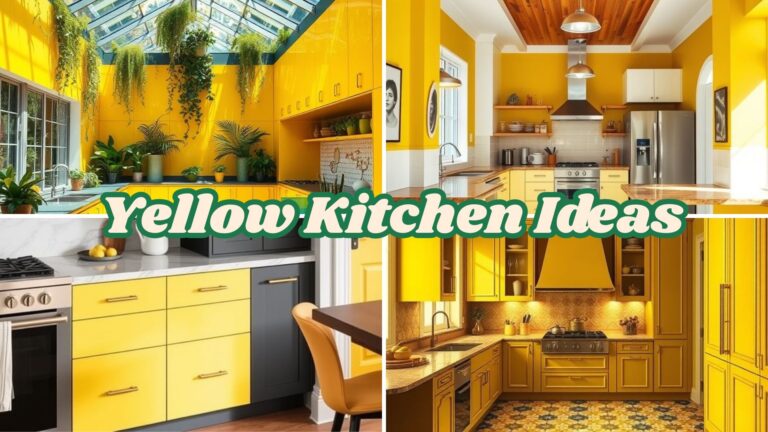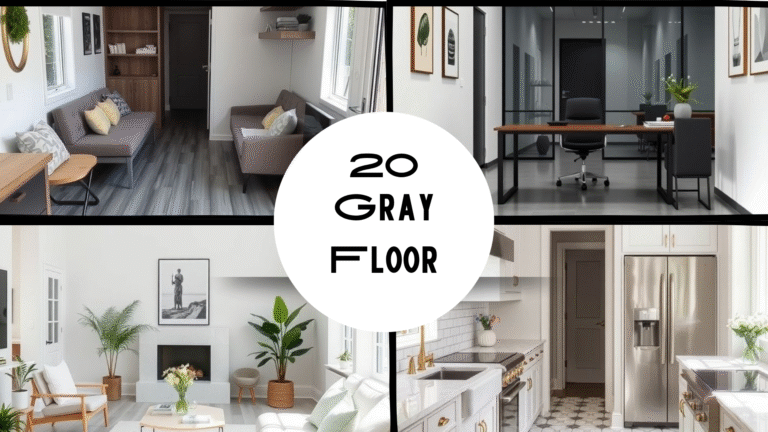Spring Decor for the Terrace: 20 Fresh, Image-Based Ideas
A little sunshine, a few flowers, and your terrace starts to feel alive again. This image-based guide brings you 20 spring-ready ideas, each crafted to be practical for small spaces and adaptable to larger terraces. You’ll find color cues, plant combinations, and styling tips that make set-up easy and maintenance lighter.
Every section ends with a clear image prompt you can hand to your designer or an AI image generator. Keep the furniture light, the colors soft, and the plants happy—spring does the rest.
1) Pastel Planters & Fresh Blooms
Pastel planters are an effortless way to signal that spring has arrived. Soft pink, mint, butter yellow, and powder blue instantly lift the mood and make even a compact terrace feel playful and warm. Keeping the tones muted helps the plants stay center stage rather than competing with loud containers.
For early color, combine tulips, pansies, petunias, and nemesia so something is always blooming as temperatures shift. Pair taller tulips with low pansies to avoid a flat, one-level look. Varied leaf shapes—like rounded petunia foliage next to slender tulip greens—add quiet texture.
Create layers by placing the tallest pots toward the back corners and stepping down in height toward the seating area. This draws the eye inward and frames your view without blocking it. If space is tight, a trio of different heights still reads as styled.
Water in the morning so leaves dry by evening and rotate the pots weekly for even growth. A slow-release fertilizer designed for flowers keeps the show going without constant mixing. Wipe the planters every few days to remove pollen and soil splashes.
If the terrace is windy, cluster pots tightly so they support each other and use gravel top-dressings to add weight. Consider lightweight fiberstone containers in pastel finishes if you want the look without the heft of ceramic.
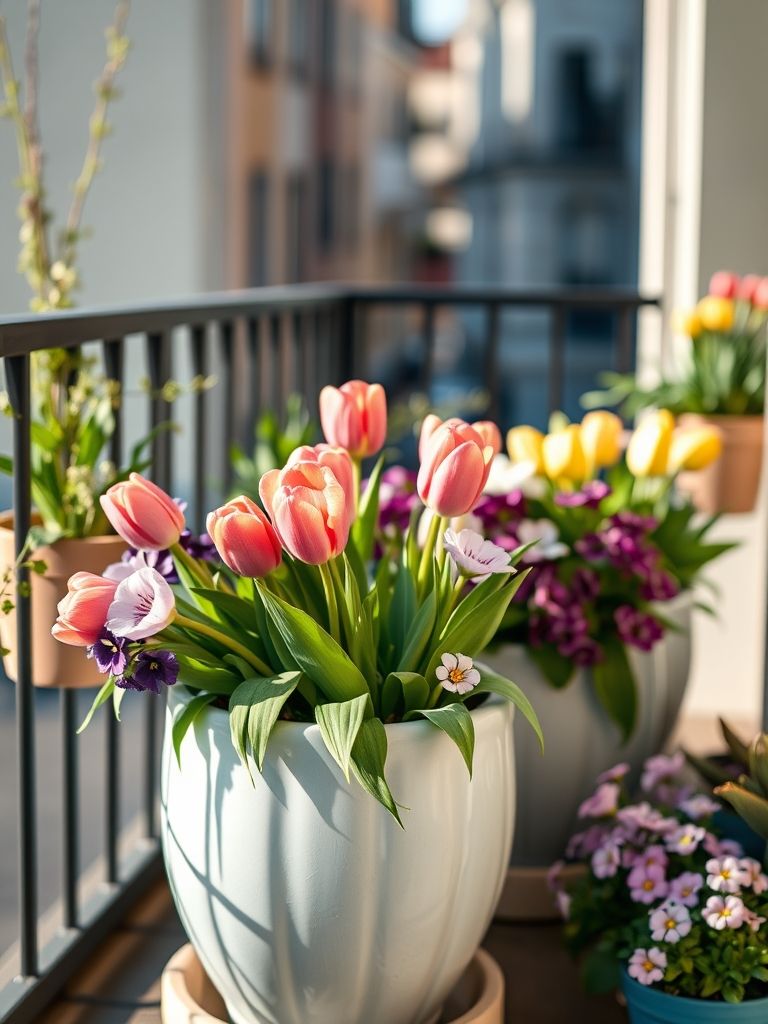
2) Botanical Cushion Refresh
Swap winter-heavy textiles for breathable cotton or linen cushions that look and feel lighter. Botanical prints—ferns, tiny florals, or lemon sprigs—suggest spring without overwhelming a small space. Keep the palette tight so the seating zone looks calm, not busy.
Choose removable covers and waterproof liners so surprise showers don’t ruin inserts. If you prefer solids, add interest through texture with slubbed linen or light quilting. A single patterned lumbar on otherwise solid cushions can be just enough.
Arrange cushions with the largest at the back and smaller accents in front to create depth. Echo one color from the cushions in a planter or lantern to tie the vignette together. A neutral throw over the armrest softens any sharp furniture lines.
Plan a simple care routine: shake out cushions weekly, spot-clean with gentle soap, and rotate their positions to even out sun exposure. If your terrace gets strong afternoon light, consider UV-resistant fabrics to reduce fading.
For tighter footprints, opt for bench pads with integrated ties so they won’t slip when people stand up. Store extra covers in a lidded basket to keep pollen off and swapping quick.
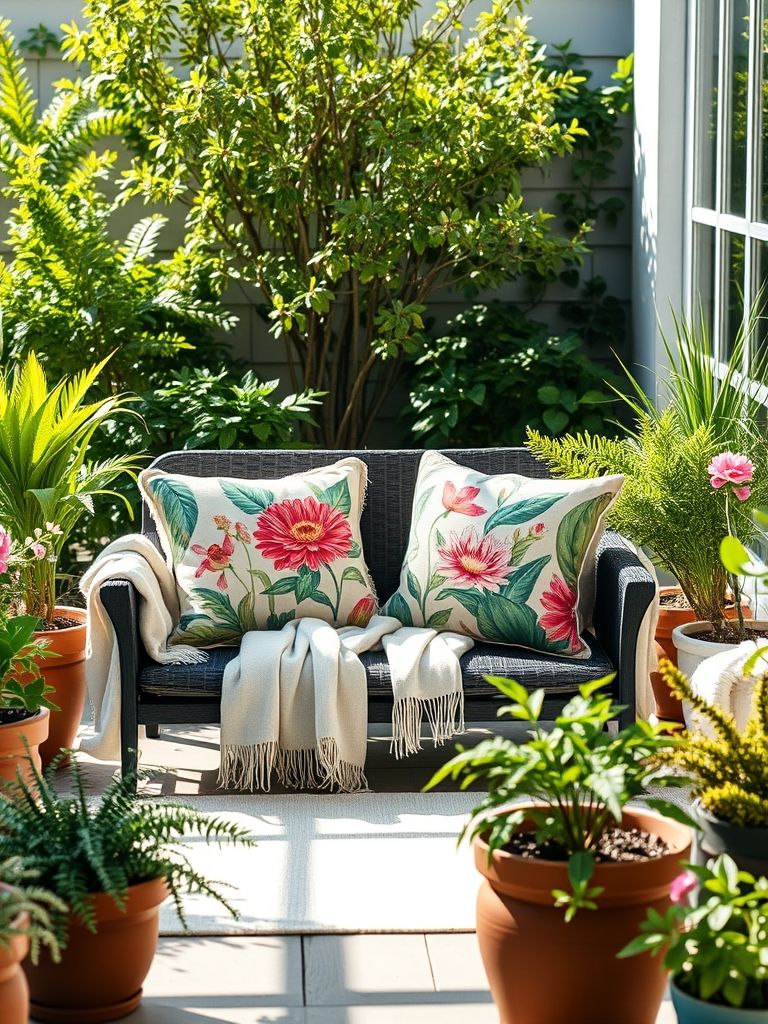
3) Layered Outdoor Rugs
Layering two slim outdoor rugs instantly zones your terrace into living and dining without adding bulky dividers. Start with a larger neutral base to visually anchor the furniture, then add a smaller patterned rug on top to bring energy and focus to the seating area.
Materials matter outdoors: polypropylene or recycled PET resist moisture, clean easily, and dry quickly. Choose a low-pile weave to avoid trapping debris and to keep chair legs stable. A subtle floral or geometric pattern reads spring without feeling seasonal-novelty.
Center the top rug under the coffee table so the edges reveal a border of the base rug all around. Align the setup with the main sightline from your door for a tidy, intentional feel. If space is very small, one well-scaled rug with a border can fake the layered look.
Maintenance is simple: shake out weekly, vacuum on low suction, and spot-clean with mild soap. Mid-season, hose down both rugs on a flat surface and let them dry thoroughly before relaying.
If your deck gets a lot of wind, place small, low-profile rug grippers at the corners to keep layers in place without creating a trip hazard.
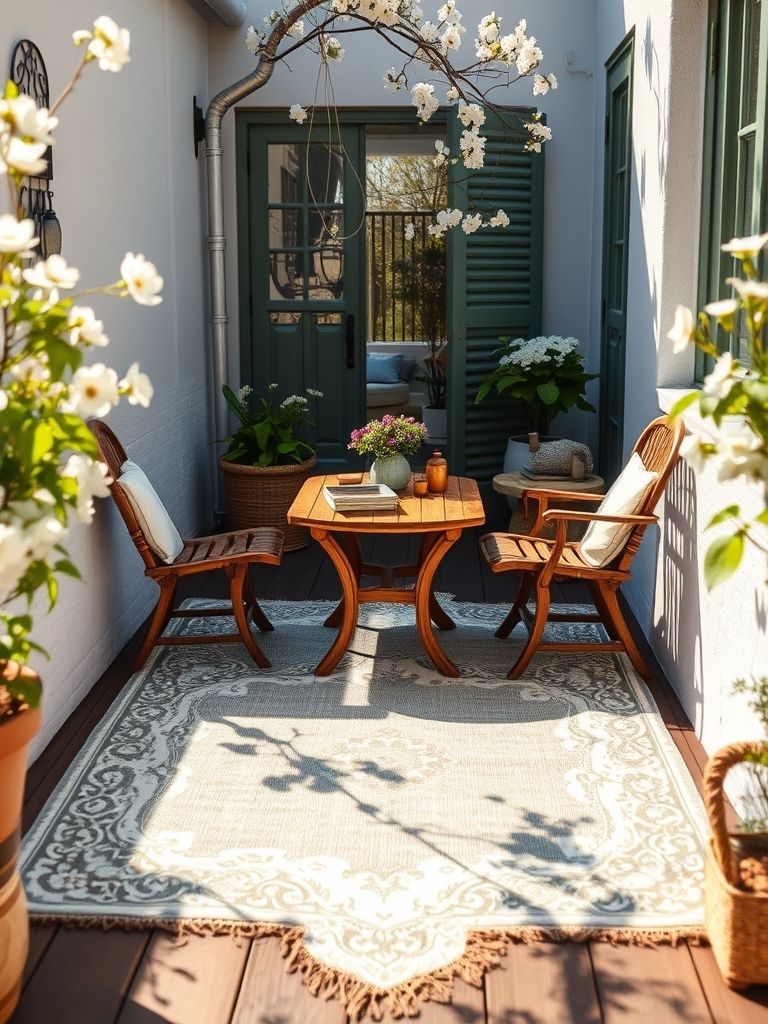
4) Bistro Breakfast Nook
A petite bistro set turns a spare corner into a morning ritual. Folding pieces are perfect for small terraces, and curved profiles soften tight corners and railings. Position the table where the first light hits to make breakfast feel extra inviting.
Keep the tabletop simple—two cups, a small tray, and a bud vase—to avoid clutter. If you like color, choose a pastel powder-coated frame and keep the tabletop neutral so food and flowers pop. A slim seat pad adds comfort without bulk.
Think vertically to save space: a thin wall shelf can hold napkins, a small jar of sugar, and matches for lanterns. A hook nearby for a throw blanket makes early spring mornings cozy. After use, fold and tuck chairs slightly to keep movement paths clear.
Wipe the table after every meal to prevent pollen rings, and check chair feet for wear so they don’t scuff decking. A tiny outdoor bin under the shelf keeps wrappers or napkins from blowing away.
If you host often, keep a compact tray prepped with essentials—stirrers, sweetener, and a small milk bottle—so setting up the nook takes seconds.
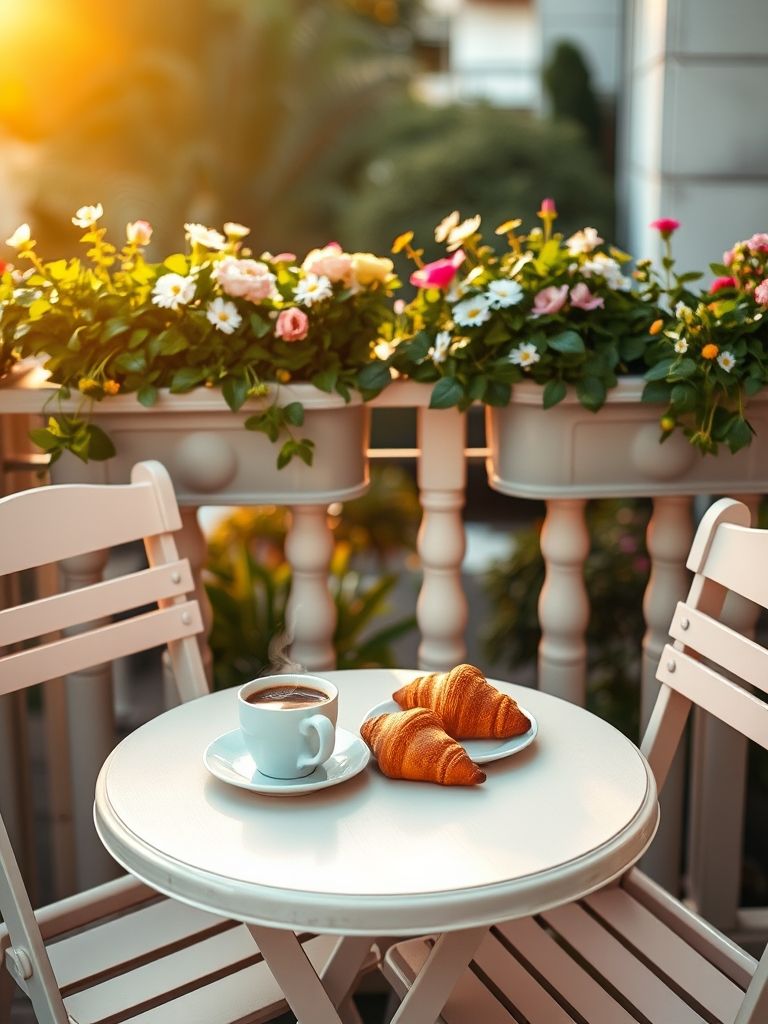
5) Rail-Hung Herb Garden
Rail planters unlock vertical real estate and keep floor space open for lounging. Plant herbs with different leaf shapes—basil, mint, parsley, and chives—so the arrangement looks lush from inside and out. Labeling each pocket is charming and practical.
Use a high-quality potting mix formulated for containers and add slow-release fertilizer at planting. Herbs prefer consistent moisture but not soggy roots, so ensure drainage holes are clear. Group herbs with similar water needs in the same planter.
Place the most fragrant herbs closest to your seating for a gentle scent as you relax. Taller chives or parsley can sit behind lower basil to create a mini tiered effect. If sun is strong, give mint partial shade to avoid wilting.
Harvest lightly and often to encourage new, tender growth. Pinch basil above sets of leaves rather than cutting stems bluntly, and keep mint trimmed to prevent it from dominating. Refresh tired plants mid-season with a top-up of soil and a quick feed.
If pets or kids can reach the rail, choose non-toxic herbs and secure the planters with secondary straps to handle unexpected bumps or wind.
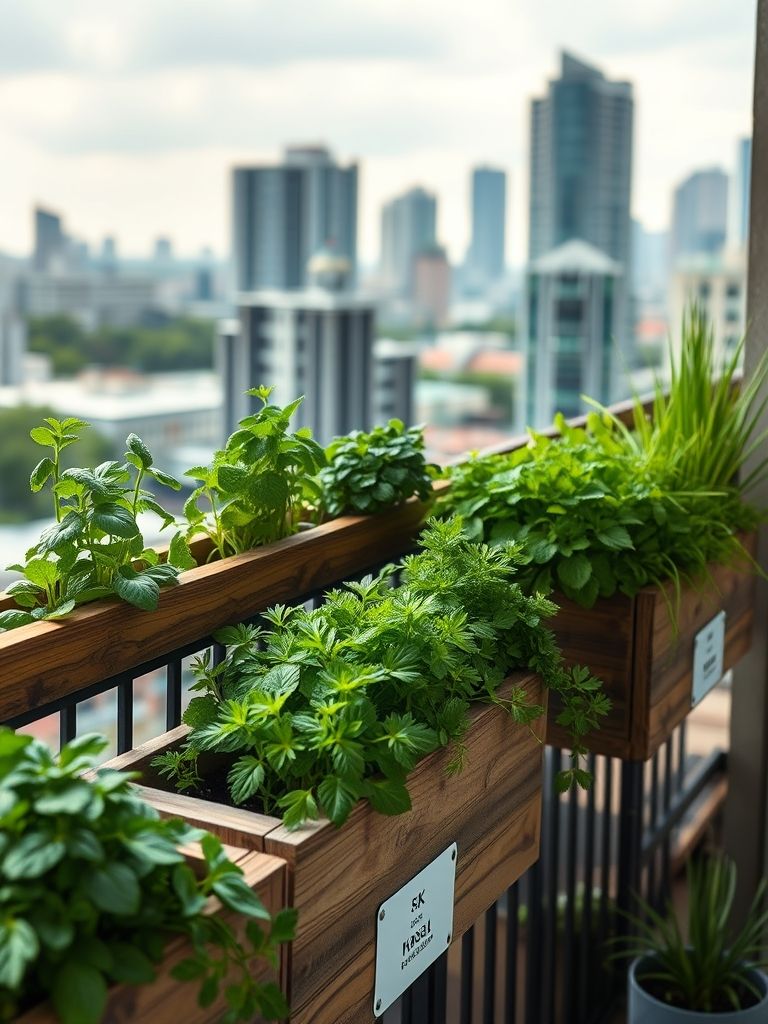
6) String Lights & Lantern Cluster
Warm string lights transform a terrace at dusk into an inviting lounge. Choose warm-white bulbs to flatter skin tones and create a soft glow rather than harsh brightness. Layer a few lanterns at different heights for depth and sparkle.
Plan the path of your lights before hanging and secure cables neatly so wind doesn’t tangle them. If you can, zigzag overhead in gentle swoops to distribute light evenly. Keep lantern finishes consistent with your furniture hardware for a cohesive look.
Timers or smart plugs are your friend—set them to switch on at dusk and off at bedtime. Battery lanterns tucked into corners add glow where outlets don’t reach. Avoid placing lights directly at eye level where they can glare.
Wipe bulbs and lantern glass weekly to clear pollen film and keep the light crisp. Check cable strain points after windy days and replace any cracked bulbs immediately for safety.
If bugs are an issue, place a low-intensity lamp away from the seating zone to draw them off while you enjoy the softer ambient lights near you.
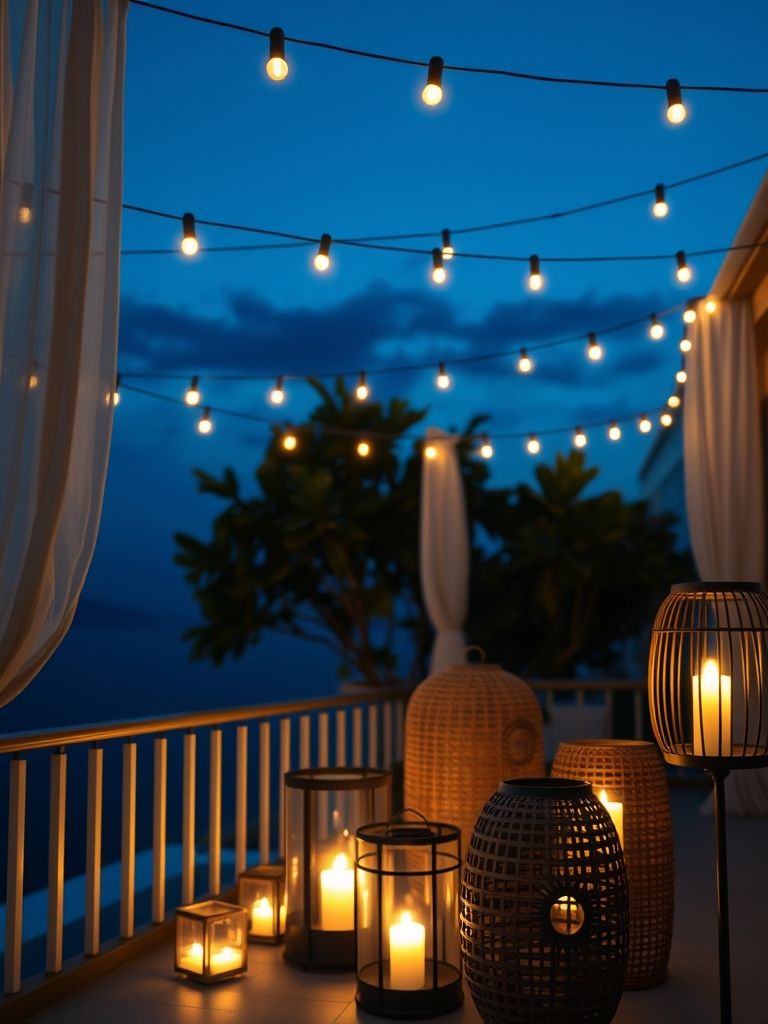
7) Vertical Trellis Wall
A trellis wall turns a plain boundary into a living backdrop in just a few weeks. Mount the trellis a few centimeters off the wall so air can circulate behind the foliage; this simple detail keeps leaves dry and discourages mildew. Fragrant climbers like star jasmine or potato vine give you both greenery and scent, which makes the whole terrace feel more immersive.
Start the growth with soft ties that won’t cut stems, guiding shoots to spread evenly rather than clump in one corner. A narrow bench or console under the trellis grounds the composition and creates a natural landing spot for a lantern, a watering can, or a small fountain. If the wall gets strong sun, a basic drip line saves time and keeps moisture consistent.
Keep pruning light and frequent through spring to encourage branching without sacrificing buds. Remove any crowded interior stems so light can reach the middle of the plant. In very windy spots, add a second set of anchors midway up so the grid doesn’t flex.
Color-wise, warm wood reads cozy, while black metal looks crisp and modern. Echo your furniture hardware so the trellis feels native to the space. A slim LED uplight aimed at the greenery makes evenings feel magical.
If you rent, consider a freestanding trellis panel in large planters so you can take the feature with you without drilling into walls.
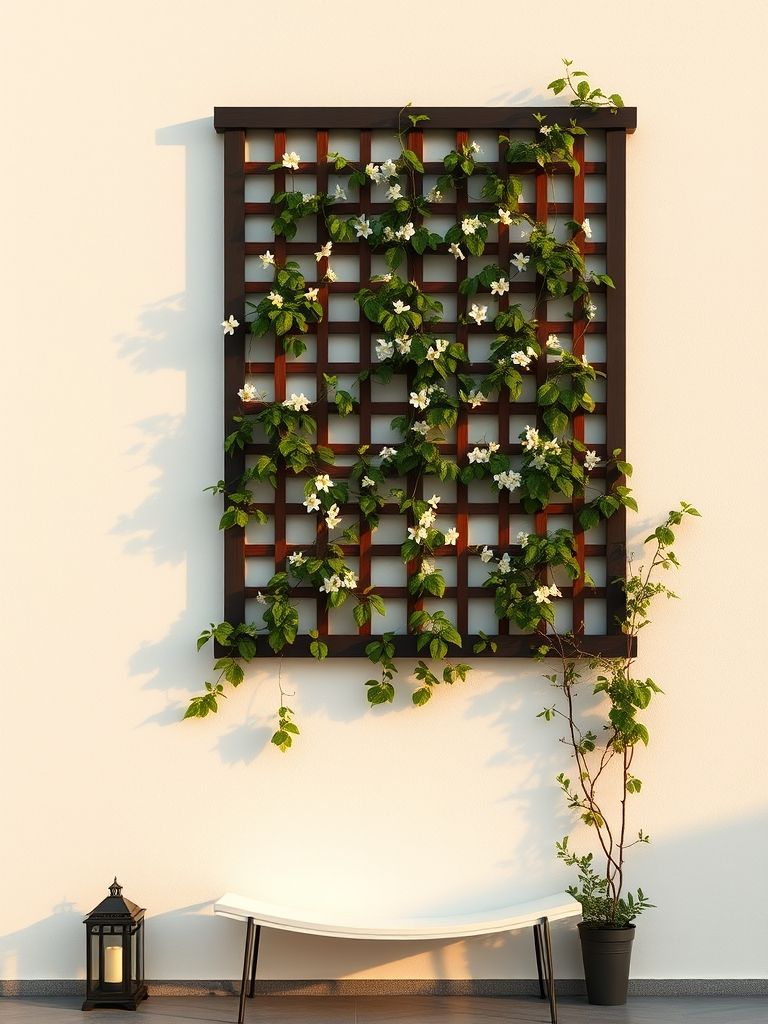
8) Flowering Bulb Boxes
Bulb boxes bring classic spring color to eye level where you’ll enjoy it most. Combine tulips, hyacinths, daffodils, and grape hyacinths for a layered look with varied heights, textures, and bloom times. If your climate swings cool to warm quickly, mix early and mid-season varieties so the show lasts.
Choose sturdy boxes with drainage and line the base with a thin layer of gravel to keep roots from sitting in water. A rich, lightweight container mix helps bulbs form strong stems that don’t flop. If wind is common, tuck a low evergreen like ivy around the bulbs to stabilize soil and hide fading foliage later.
Place boxes along the railing to frame the view without blocking it. Stagger the heights slightly so the display feels casual rather than rigid. If privacy matters, stack two boxes on a tiered stand to create a soft floral screen.
Deadhead spent blooms promptly to push energy back into bulbs for next year, and let the foliage die back naturally before cutting. A light feed after flowering helps replenish reserves. By early summer, switch the boxes to heat-tolerant annuals and your terrace keeps rolling.
If your railing gets full sun, rotate boxes a quarter turn every few days to keep stems straight instead of reaching only toward the light.
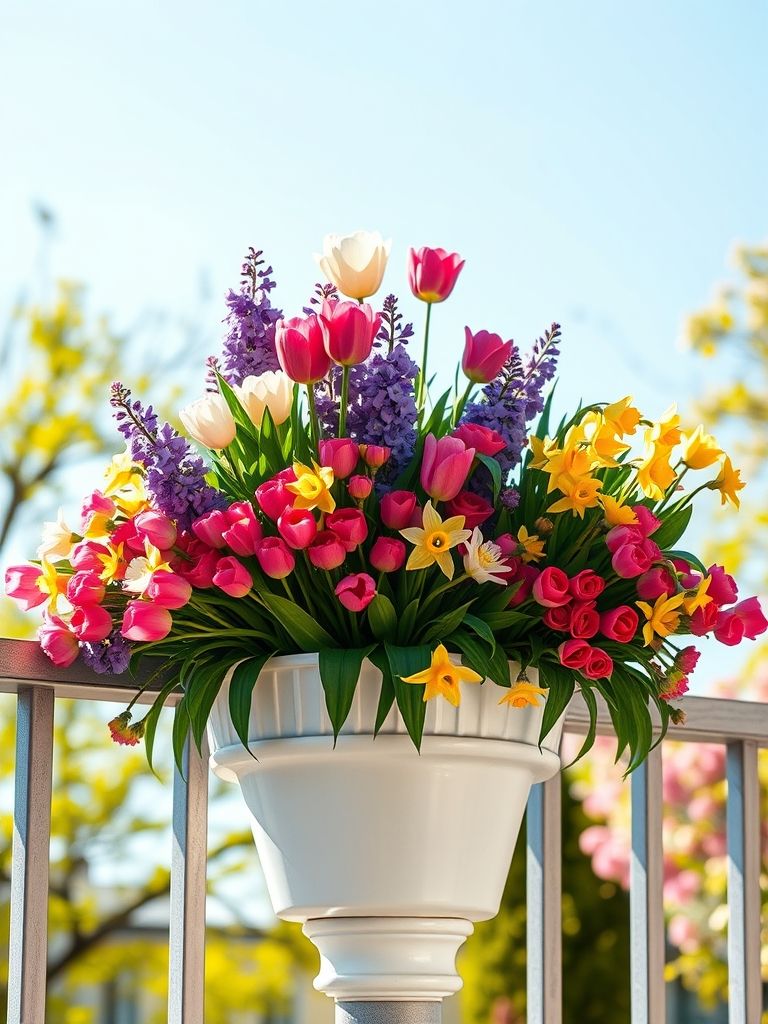
9) Terracotta Comeback
Terracotta warms up cool palettes instantly and pairs beautifully with spring greens. Mix classic rounds with tall amphora silhouettes so the grouping feels collected over time rather than store-bought in one go. The earthy color harmonizes with everything from pale pastels to charcoal decking.
Before planting, soak dry terracotta in water so it doesn’t pull moisture from the soil. Seal the exterior if your climate sees heavy rain or sharp temperature swings; it helps prevent cracking and efflorescence. Felt pads under saucers protect decking and make it easier to slide pots for cleaning.
Plant scented geraniums, rosemary, or daisies for a cottage note that suits the rustic clay. Repeat one plant across a few pots to tie the collection together, then add a “hero” pot with something showy near the entrance. A top-dressing of small gravel keeps soil splash down during storms.
Maintenance is simple: water when the top couple of centimeters are dry, and rotate weekly so growth stays balanced. If algae forms, wipe the pot with a soft brush and a little vinegar solution, then rinse thoroughly.
For lighter weight with the same look, try fiber-clay or resin terracotta replicas; they’re easier to move and more forgiving in extreme temperature swings.
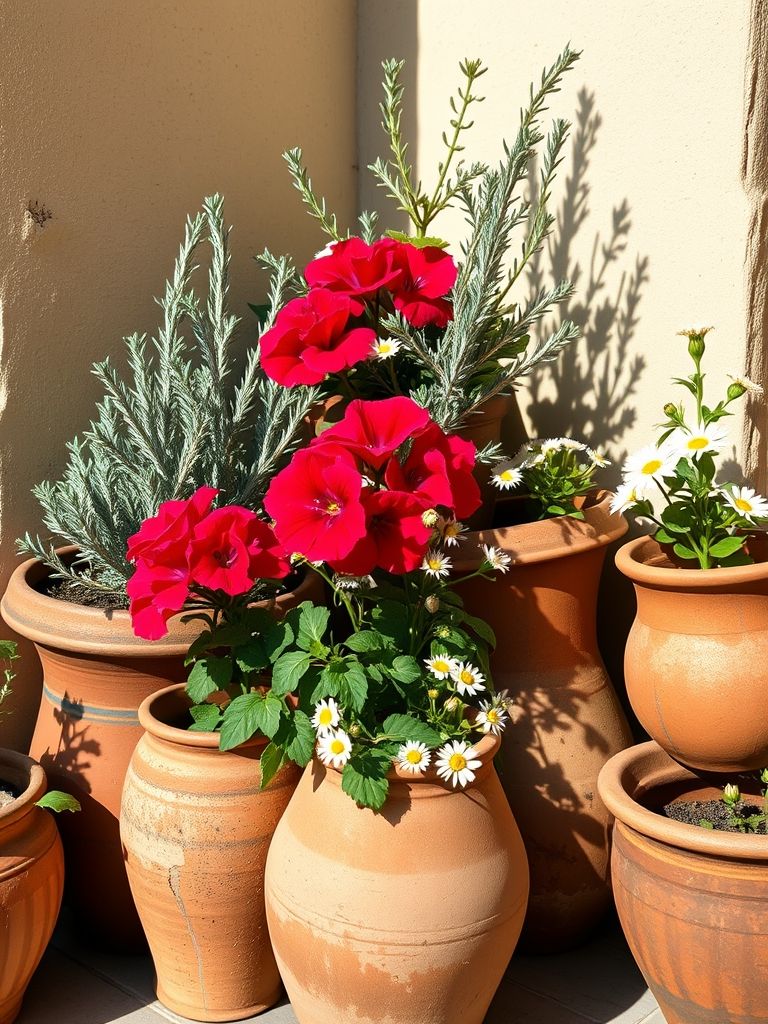
10) DIY Painted Pot Parade
Refreshing old pots with masonry paint gives your terrace an instant seasonal lift. Choose two complementary base colors—say, soft sage and buttercream—and add a third accent for stripes, dots, or half-dips. Painter’s tape yields crisp lines; peel it while the paint is just tacky for the cleanest edge.
Seal with a clear, non-yellowing outdoor topcoat so scuffs wipe away easily. Keep patterns simple and repeat them across sizes to create rhythm without visual noise. Arranging pots by color gradient—from lightest to darkest—adds a playful, curated feel.
Plant easy crowd-pleasers like daisies, nemesia, or trailing lobelia so the foliage doesn’t fight the graphics. Leave negative space between groupings; the breathing room makes each cluster read as intentional. If storage is tight, stack light pots into a tidy column when not in use.
Spot-clean painted areas with a damp cloth rather than scrubbing, and reapply sealer at the end of the season if needed. When the colors fade, lean into the patina or add a new accent shade next spring.
If you want a more artisanal effect, hand-paint loose florals or brushy stripes; small imperfections add charm and keep the look from feeling mass-produced.
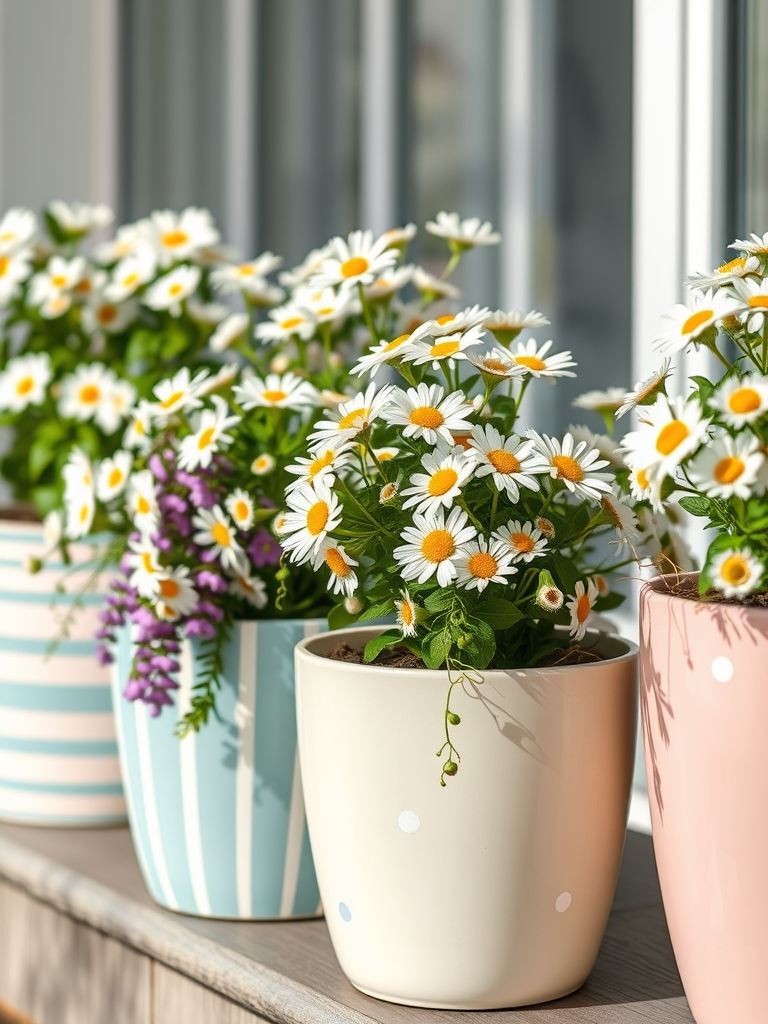
11) Fresh Doormat & Spring Wreath
A new doormat and a slim wreath are small changes with big “welcome” energy. Coir mats are durable and hide pollen well, while a simple motif keeps the look timeless. For the wreath, eucalyptus, olive, or tiny blossoms suit spring without veering into holiday territory.
Scale matters: choose a wreath that spans about one-third to one-half the door width so it feels proportional. Use a clear removable hook so swaps are quick as seasons change. Flank the doorway with matching planters to create a friendly symmetry.
If your terrace door opens outward, mind the swing path so pots and wreath depth don’t interfere. A narrow umbrella stand or boot tray nearby catches drips on rainy days and keeps the entry tidy. Echo one accent color from the wreath in your planters for cohesion.
Dust the wreath and shake the mat weekly to manage pollen buildup. A quick hose-down of the mat every few weeks revives the fibers and resets the color.
For a subtle scent, tuck a sprig of dried lavender or eucalyptus behind the wreath; it perfumes the entry without attracting insects.
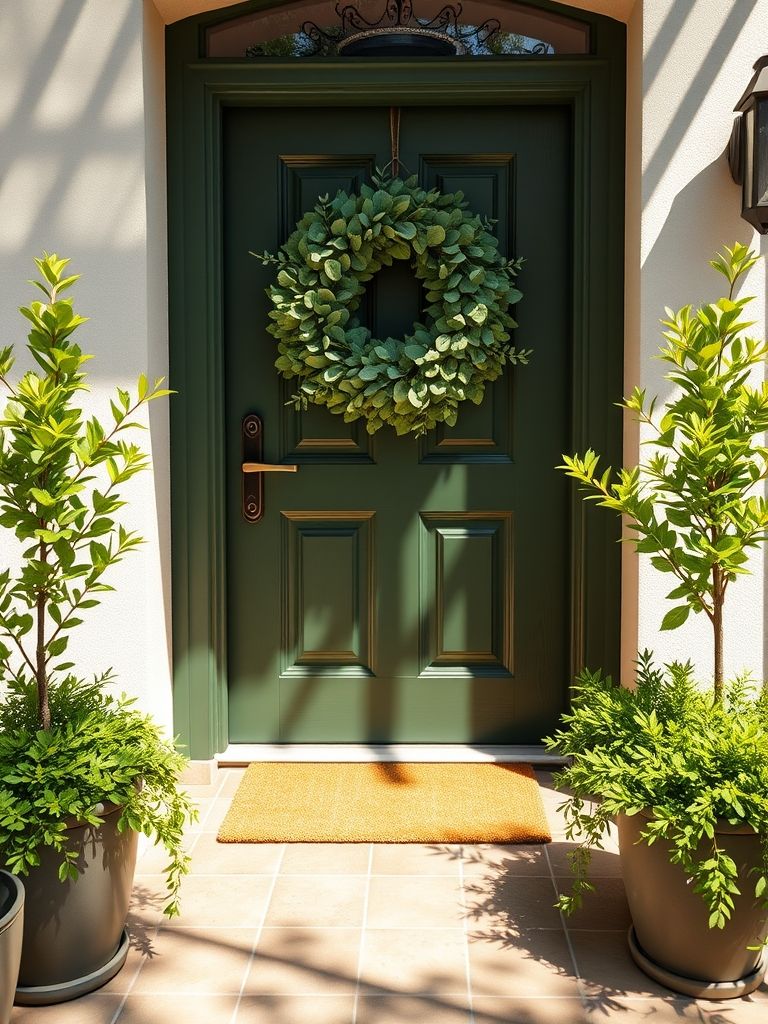
12) Outdoor Art & Mirror Accent
Weather-safe prints and metal art lend personality where plants can’t. A slim outdoor-rated mirror bounces light into darker corners and visually expands the space. Position the mirror where it reflects greenery or sky rather than direct sun to avoid glare.
Keep frames and finishes in the same family as your hardware so nothing feels random. A tight trio—two prints and one mirror—reads curated and keeps the wall from feeling busy. If wind is an issue, use low-profile mounting and adhesive pads to prevent rattle.
Layer a tall plant or lantern just below the arrangement to connect the wall art with the floor plane. The vertical stack draws the eye up and makes even a small terrace feel designed. Wipe frames weekly so dust and pollen don’t dull the shine.
Swap prints seasonally if you like variety; botanical line drawings and watercolors pair especially well with spring textures. If moisture is high, choose UV-printed aluminum panels for crisp color that lasts outdoors.
If you’re renter-conscious, use removable hooks and weather-rated hook-and-loop strips so you can change the layout without drilling.
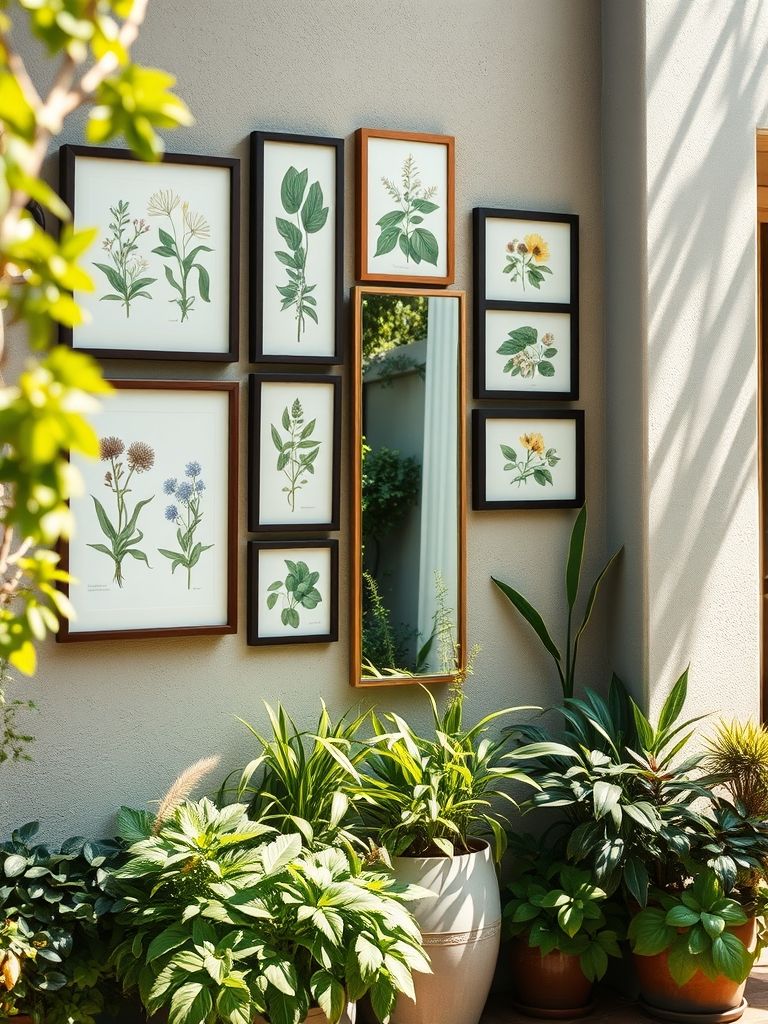
13) Mini Water Feature
A tabletop fountain adds a calming sound layer that masks street noise and makes the terrace feel like a retreat. Pick a self-contained bowl or urn with a quiet pump so the hum doesn’t compete with the trickle. Place it near seating where you can hear it without raising the volume.
Add smooth river stones around the spout to soften the look and control splash. If your style is modern, choose a simple, matte finish; for rustic spaces, try weathered stone or terrazzo. A small fern or moss beside the bowl completes the vignette.
Keep water topped up so the pump stays submerged and lasts longer. Clean the reservoir monthly and wipe surfaces to prevent mineral buildup. If leaves drift into the bowl, a small mesh screen under the pebbles makes cleanup easy.
At night, a tiny submersible light turns the fountain into a glowing focal point. Use a smart plug so you can switch it off with the rest of your evening scene.
If mosquitoes are an issue, ensure gentle water movement at all times and refresh the basin frequently to discourage larvae.
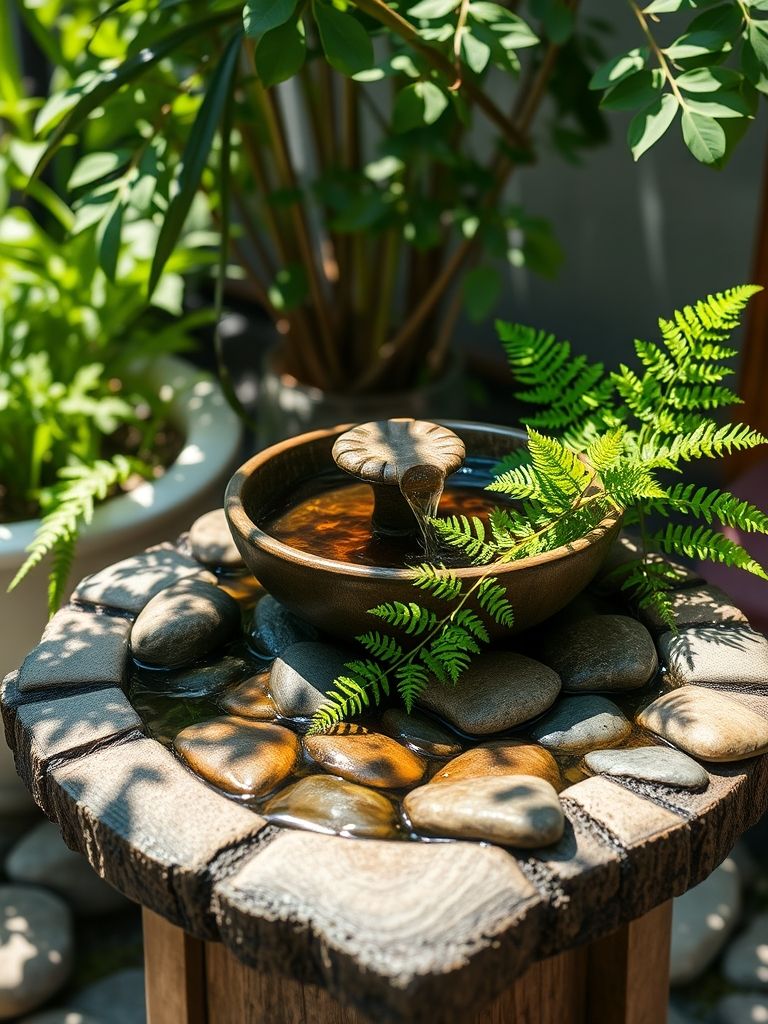
14) Shade with Umbrella or Sail
Spring sun can be bright even when the air is cool, so plan simple shade you can adjust. A compact, tilting umbrella works for tight spots and folds away cleanly. For longer spans, a triangular shade sail gives crisp lines and excellent coverage without a heavy base.
Angle shade to protect the table at midday and your lounge in late afternoon. Light fabrics feel airy but should still block UV; look for outdoor-rated materials that resist fading. If your terrace is windy, secure all points firmly and check after gusty days.
Keep clearances in mind: give headroom above the dining zone and leave pathways unobstructed. Light bounces under pale fabrics, creating a bright but softened environment that’s perfect for reading or hosting.
Clean fabric with mild soap and a soft brush, then air-dry fully before stowing. A quick rinse every couple of weeks keeps pollen from staining.
If drilling isn’t an option, use weighted bases or clamp-on poles designed for balconies to support shade without permanent fixtures.
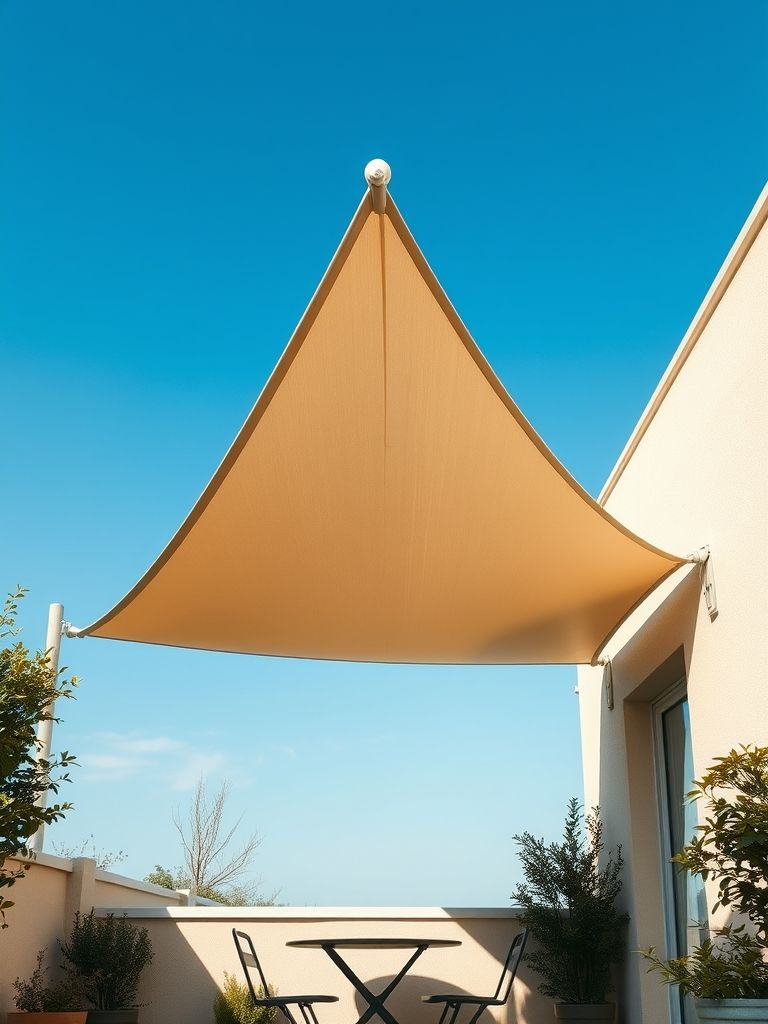
15) Scented Corner
Create a fragrant micro-zone with lavender, sweet alyssum, and lemon thyme clustered near your favorite chair. Grouping scents concentrates the effect so a light breeze drifts the aroma right where you sit. Choose breathable clay or fiberstone planters to avoid soggy roots.
Design for texture as well as scent: spiky lavender, lacy alyssum, and tiny thyme leaves look beautiful together. Keep the tallest plant at the back and let alyssum spill over the rim to soften edges. If bees are frequent visitors, place the cluster a step away from the main walkway.
Trim gently after flowering to keep plants compact and encourage fresh flushes. Water in the morning so leaves dry by evening, and feed sparingly so fragrance stays strong. If space allows, tuck a small wind chime nearby for a subtle sound layer.
A neutral cushion and throw on the adjacent chair invite lingering. In the evening, add one lantern with a low, warm glow to extend the mood.
If you prefer a citrus-forward profile, substitute lemon verbena for lavender and add a pot of basil to amplify the fresh, green note.
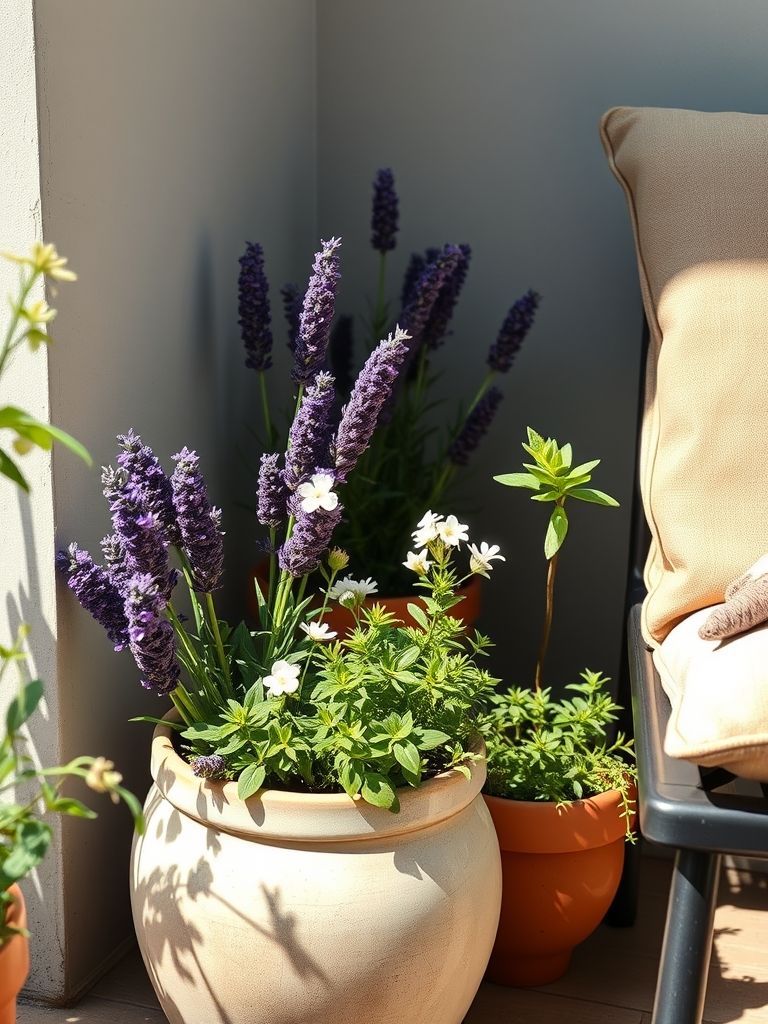
16) Bird-Friendly Spot
Inviting birds adds life and gentle motion to your terrace. A small feeder with no-sprout seed keeps mess down, and a shallow dish of water doubles as a birdbath. Place both a short distance from the dining area so you can watch without crumbs and splashes near the table.
Add a slim branch or trellis segment as a perch so visitors feel secure. If privacy matters, position the setup near screening plants; birds prefer a quick escape path. Keep glass safe by using decals or hanging a small tassel so panes are visible.
Clean the feeder and water dish weekly to keep birds healthy, and refresh seed before it clumps. If pigeons or aggressive species appear, switch to blends they dislike and reduce platform perches.
Over time, you’ll learn which species visit in spring and can tailor seed to their favorites. A compact field guide or app makes identification fun.
If you have close neighbors, choose quiet, non-chiming accessories and avoid feeders that spill; a tidy setup keeps everyone happy.
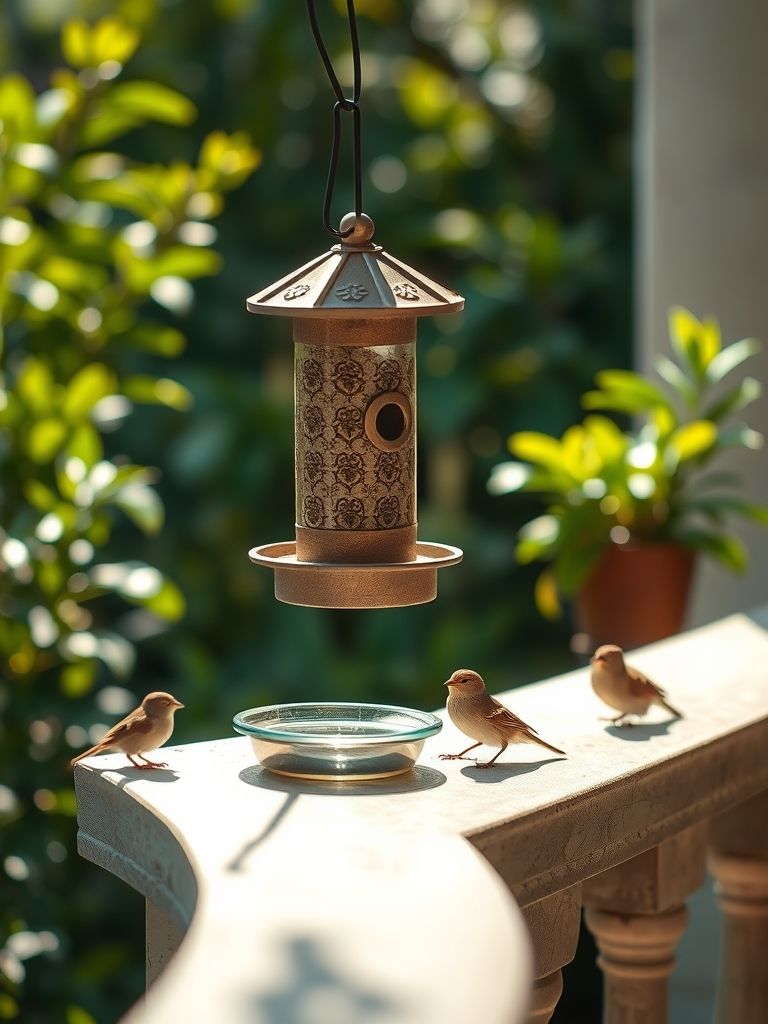
17) Spring Tablescape
A simple, fresh tablescape shifts the terrace from “place to sit” to “place to gather.” Start with a linen runner, plain plates, and clear glassware; the calm base lets seasonal flowers shine. One low arrangement keeps sightlines open and conversation easy.
Repeat a soft stripe or gingham on cloth napkins to nod to spring without kitsch. If you love color, let the florals provide it and keep plates neutral. Wooden or rattan chargers introduce warmth that balances cool metals and glass.
For a small table, choose a compact centerpiece like a low bowl of tulips or ranunculus. Scatter two tea lights in lidded jars so you can snuff them safely. A tiny salt cellar and a lemon on a small plate add both function and visual charm.
Wipe surfaces after each meal so pollen doesn’t stain textiles. Store the runner rolled, not folded, to avoid creases when you bring it back out.
If evenings are breezy, choose heavier tumblers and clip the runner at the ends underneath so the tablescape stays neat.
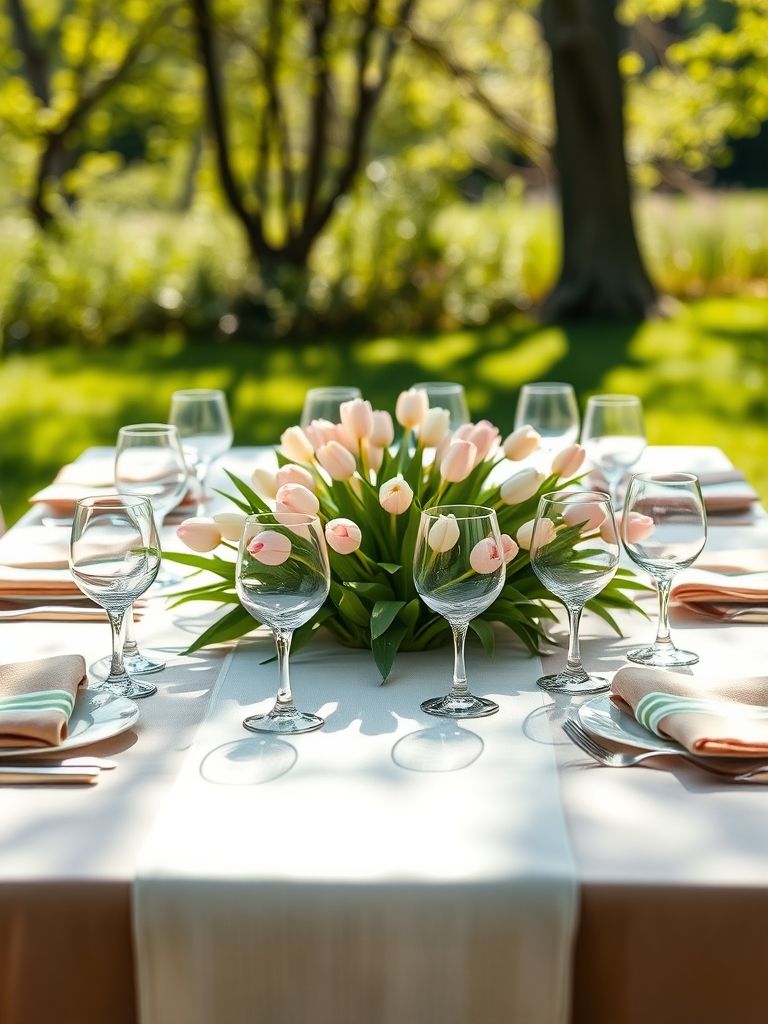
18) Compact Bar Cart
A slim bar cart makes hosting effortless without cluttering the terrace. Choose a two-tier model with rails so items don’t slide when you move it. Stock sparkling water, lemonade, and a few tumblers, then add a bowl of citrus and a small ice bucket for instant service.
Locking wheels keep the cart steady on slightly uneven decking. If outlets are nearby, a tiny jug blender turns it into a mocktail station. Keep a folded tea towel on the handle and a small trash jar on the bottom shelf to corral peels and napkins.
Style the cart with restraint: one plant, one decanter, and a short stack of glasses look elegant and functional. Group by height so the display feels tidy, and leave an open patch for a serving tray.
Wipe metal surfaces often; spring pollen shows quickly. At night, a rechargeable lamp on the top shelf adds just enough glow to feel festive.
If space is extremely tight, use a wall-mounted fold-down shelf with rails to mimic a cart’s function without the footprint.
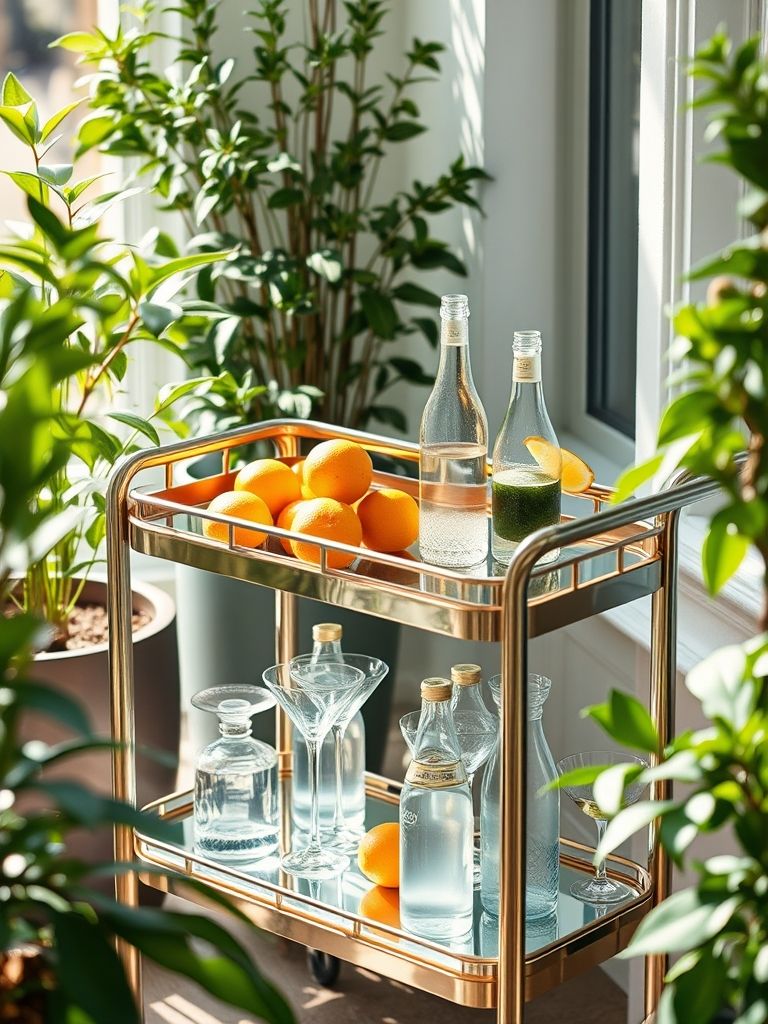
19) Cozy Evening Layers
Spring nights can be crisp, so plan soft layers that extend your outdoor time. Keep thin throws in a lidded basket by the sofa where they’re easy to grab. A thick seat pad placed where the breeze hits most makes a surprising difference in comfort.
If allowed, a compact tabletop heater or smokeless fire bowl adds a gentle warmth; place it where it won’t crowd elbows. Lanterns with warm-white LEDs create pools of light that feel intimate without glaring. Aim for a few glow points at different heights rather than one bright source.
Choose textiles you can wash easily and stick to a limited palette so the look remains serene. A single patterned throw across the back of the sofa adds interest without busyness. When you’re ready to pack up, toss everything back into the basket and clip lanterns to a timer.
Check local safety guidelines before adding heat sources, and keep a metal lid handy to snuff flames quickly. Wipe soot or residue from surfaces right away so it doesn’t set.
If you’re scent-sensitive, avoid fragranced candles outdoors; instead, rely on visual warmth from lanterns and the physical warmth of throws.
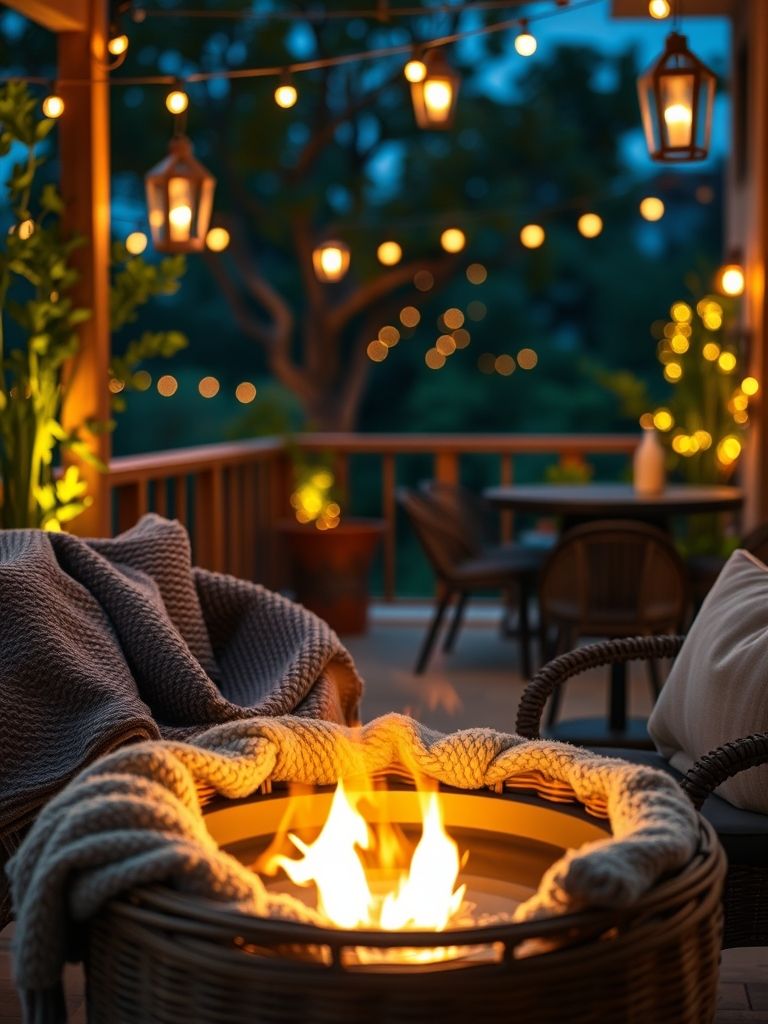
20) Small-Space Zoning with Planters
Use planters as gentle dividers to carve a lounge, a dining spot, and a reading nook without hard walls. Tall grasses or bamboo create vertical rhythm and soft privacy around a chair, while low herbs frame the dining area. Keeping pathways clear makes movement feel effortless.
Repeat one plant—like lavender or rosemary—across zones to tie the whole terrace together. Vary container heights and shapes so each cluster feels intentional but related. If your deck is narrow, align tall pieces to one side and keep the center light.
Test your layout for a week and notice how you naturally move. Nudge pots as needed so doors swing freely and chairs slide out without snagging. A single, slim obelisk or tuteur in one zone adds vertical interest without bulk.
Maintenance stays simple when you group plants by water needs. Add discreet saucers or hidden drip trays to protect the floor and make cleanup fast. As the season progresses, rotate any leggy plants to sunnier spots so each zone stays lush.
For renters, mobile planter boxes on casters let you reconfigure zones for parties or cleaning days without heavy lifting.
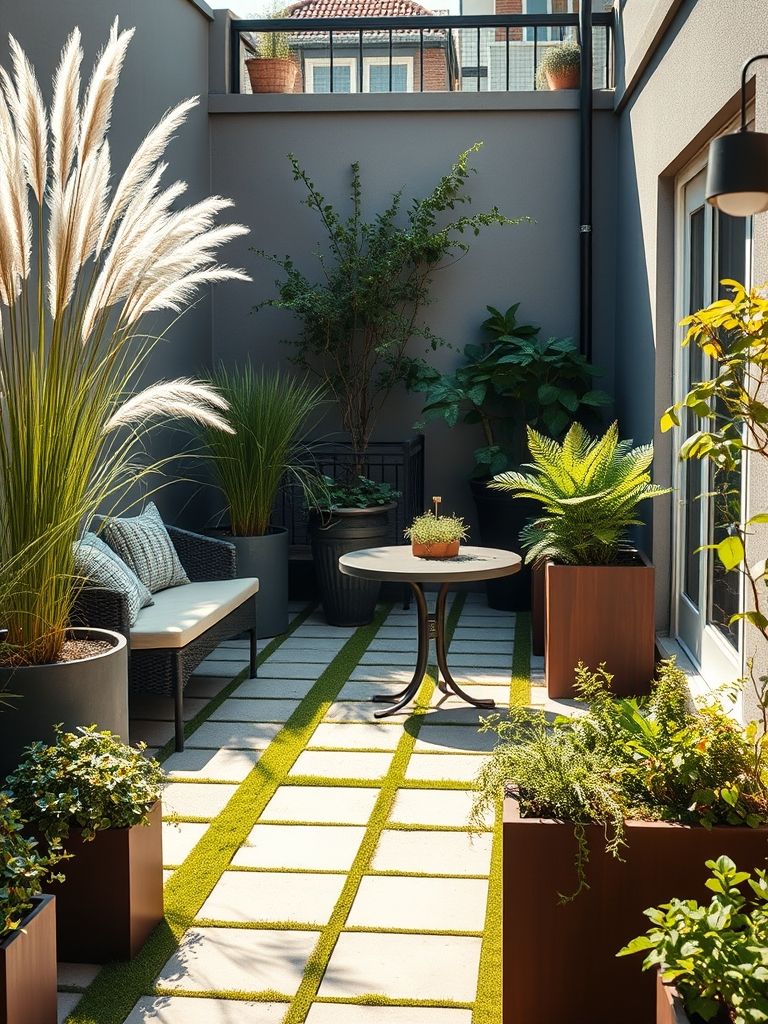
Conclusion on Spring Decor for the Terrace
Spring decor doesn’t need to be dramatic or expensive to change how your terrace feels; it just needs intention. When you layer color, scent, and gentle lighting, even a compact space reads as welcoming and lived-in. Start with two or three ideas—perhaps pastel planters, a bistro nook, and string lights—then let the rest follow naturally as the season unfolds.
Think of your terrace as a set of small scenes that work together: a place to sip coffee, a corner to read, a table to gather. Planters can double as soft dividers, textiles add comfort without bulk, and a few well-placed lanterns make evenings linger. Keep palettes tight and repeat materials so the whole space feels cohesive rather than pieced together.
Maintenance is what keeps the look effortless. Water in the morning, rotate pots for even growth, wipe pollen from textiles and glass, and prune little and often. Choose outdoor-rated finishes, protect decking with saucers, and use timers or smart plugs so ambiance happens automatically.
Most of all, let spring do the heavy lifting. Fresh foliage, gentle breezes, and natural light make every vignette look better than you planned. Use the image prompts to visualize your next tweak, take a quick before/after photo to track what’s working, and keep refining—one small, joyful change at a time.





